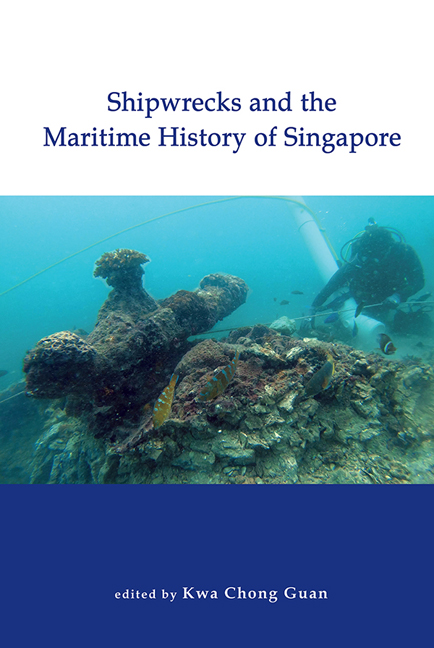Book contents
- Frontmatter
- Contents
- Foreword
- Acknowledgements
- Contributors
- 1 Introduction: Two Historical Shipwrecks and Their Implications for Singapore History
- 2 The Temasek Wreck
- 3 The International History of Temasek: Possibilities for Research Emerging from the Discovery of the Temasek Wreck
- 4 Singapore’s Waterways before the Modern Era
- 5 A Seventeenth-Century Port Settlement in the Kallang Estuary
- 6 The Shah Muncher
- 7 Singapore and the Country Trade in the Late Eighteenth and Early Nineteenth Centuries
- Index
2 - The Temasek Wreck
Published online by Cambridge University Press: 01 March 2024
- Frontmatter
- Contents
- Foreword
- Acknowledgements
- Contributors
- 1 Introduction: Two Historical Shipwrecks and Their Implications for Singapore History
- 2 The Temasek Wreck
- 3 The International History of Temasek: Possibilities for Research Emerging from the Discovery of the Temasek Wreck
- 4 Singapore’s Waterways before the Modern Era
- 5 A Seventeenth-Century Port Settlement in the Kallang Estuary
- 6 The Shah Muncher
- 7 Singapore and the Country Trade in the Late Eighteenth and Early Nineteenth Centuries
- Index
Summary
The fourteenth-century Temasek Wreck was excavated recently off Pedra Branca by the Archaeology Unit (AU) of the ISEAS – Yusof Ishak Institute (ISEAS) on behalf of the Singapore National Heritage Board (NHB). Details of the discovery, survey, excavation and outcomes are provided in the ISEAS publication Temasek Working Paper Series no. 4. Key findings, such as the cargo composition, date of loss, likely origin of the ship, probable port of lading and most likely destination are presented here, but not as stand-alone outcomes. The aim is to place the Temasek Wreck within the context of contemporary shipwrecks in this region in order to better understand the significance of early Singapore in the realm of regional maritime trade.
The Temasek Wreck
The Temasek Wreck was excavated intermittently from 2016 until 2019. Approximately 3.5 tonnes of ceramics were recovered, but little else. The ship itself had completely vanished. Without the anaerobic protection of deep and fine sediments, the hull has been scattered by waves and currents and consumed by Teredo worms.
While some intact examples have been retrieved, most of the ceramics are in the form of shards. Stoneware storage jars and smallmouth jars—most likely from Cizao—Longquan celadon dishes, bowls and jars and qingbai ware from Jingdezhen form the vast majority. There are small quantities of crude Fujian greenware, Dehua whiteware and fine shufu ware. But the most impressive element of the ceramic cargo is an extensive repertoire of rare Yuan dynasty blue-and-white porcelain, far more than has ever been recovered from a documented wreck site anywhere else in the world.
Without dated coins or organic material suitable for radiocarbon analysis, dating can only be attempted through the stylistic analysis of the ceramics cargo.
Longquan celadon first appeared in the twelfth century. It was favoured throughout most of the thirteenth century by the Song imperial court for its sumptuous jade-like attributes. During the fourteenth century, the Longquan kilns expanded production to cater to an ever-increasing demand for a wide repertoire of large moulded shapes from domestic and foreign markets. The array of Longquan celadon recovered from the Temasek Wreck is typical of the fourteenth century, but being more specific can be contentious due to the longevity of various decorative techniques and patterns.
- Type
- Chapter
- Information
- Shipwrecks and the Maritime History of Singapore , pp. 20 - 38Publisher: ISEAS–Yusof Ishak InstitutePrint publication year: 2023

